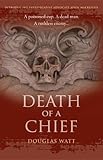 This week’s letter in Kerrie’s Crime Fiction Alphabet is D:
This week’s letter in Kerrie’s Crime Fiction Alphabet is D:
Douglas Watt is a historian, poet and novelist. Death of a Chief is his first novel.
From the back cover:
The year is 1686. Sir Lachlan MacLean, chief of a proud but poverty-stricken Highland clan, has met with a macabre death in his Edinburgh lodgings. With a history of bad debts, family quarrels, and some very shady associates, Sir Lachlan had many enemies. But while motives are not hard to find, evidence is another thing entirely. It falls to lawyer John MacKenzie and his scribe Davie Scougall to investigate the mystery surrounding the death of the chief, but among the endless possibilities, can Reason prevail in a time of witchcraft, superstition and religious turmoil?
Death of a Chief is set in pre-Enlightenment Scotland – a long time before police detectives existed.
I seem to be reading a lot of crime fiction set in Edinburgh recently with Ian Rankin’s Rebus series, but Death of a Chief is set in a different period and at times, it seemed, a different place! One location that puzzled me was the Nor’ Loch below Castle Rock, where a second body is found – that of James Jossie, the apothecary – I just couldn’t picture a loch actually within the city. I found the answer in Wikipedia – this area is now occupied by Princes Street Gardens, between the Royal Mile and Princes Street. How different it was before it was drained in 1759, with its muddy shoreline, and its dark dank water in the shade of the black mass of the Castle Rock!
Although I know very little about 17th century Scotland it seemed to me that this book brought that time and place to life well.The differences between the Highlanders and Scots Lowlanders are highlighted. Scougall a devout Presbyterian Lowlander has been brought up believing the Highlands to be a barbaric place ‘roamed by bands of murderers and in the grip of Popery’. The difficulties of language also confront Scougall – he can’t speak Gaelic. As MacKenzie and Scougall travel into the Highlands to attend Sir Lachlan’s funeral and search for Campbell of Glenbeg, a notorious drunkard and gambler and a suspect for the murders, it seems that Scougall’s fears are justified when they are attacked by a group of “caterans”, men without a clan who were hired to kill them.
Although the locations are well described and MacKenzie (based on a real historical figure) and Scougall are well drawn some of the other characters are a bit sketchy and I had a little difficulty identifying them as I read. I had to backtrack to remind myself who they were. But I liked Watt’s style of writing. I enjoyed the book’s historical background and the way he portrayed the political and religious conflict. The tension is well paced and the mystery is intriguing. I just had to keep turning the pages to find who was the culprit and I didn’t work it out until just before the denoument.
>How different it was before it was drained in 1759, with its muddy shoreline, and its dark dank water in the shade of the black mass of the Castle Rock!
That is hard to imagine!
Sounds like an interesting mystery–I like historical ones myself.
LikeLike
Sounds a good one Margaret. I can just picture Princes Street Gardens as a lake. Thanks for taking part
LikeLike
I like historical mysteries. Wiorth checking it out.
Here is my Crime Fiction Alphabet: D post!
LikeLike
I like historical novels where the author has taken the time to research the place and make it as authentic as possible. It sounds like this author has.
LikeLike